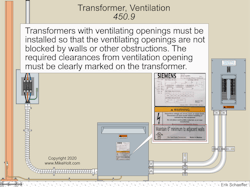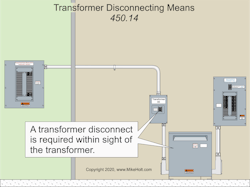Courtesy of www.MikeHolt.com
All questions and answers are based on the 2020 NEC.
Q. What are the NEC requirements for transformer ventilation clearances?
A. Transformers must be installed per the manufacturer’s instructions, and their ventilating openings are not permitted to be blocked [Sec. 110.3(B)]. The required clearances from the ventilation opening must be clearly marked on the transformer (Fig. 1).
Q. What is the NEC rule regarding disconnecting means on the supply side of a transformer?
A. A transformer disconnect within sight of the transformer is required, unless the location of the disconnect is field marked on the transformer, and the disconnect is capable of being locked in the open position with provisions for locking to remain in place whether the lock is installed or not (Sec. 110.25 and Sec. 450.14), as shown in Fig. 2.
“Within Sight” means that it is visible and not more than 50 ft from the location of the equipment [Art. 100].
Q. What type of battery interconnections are allowed by the Code for storage batteries?
A. Flexible cables, as identified in Art. 400, in sizes 2/0 AWG and larger are permitted within the battery enclosure from battery terminals to a nearby junction box where they must be connected to an approved wiring method. Flexible battery cables are also permitted between batteries and cells within the battery enclosure. Such cables must be listed and identified for the environmental conditions. Flexible, fine-stranded cables may only be used with terminals, lugs, devices, or connectors per Sec. 110.14 [Sec. 480.12].
These materials are provided to us by Mike Holt Enterprises in Leesburg, Fla. To view Code training materials offered by this company, visit www.mikeholt.com/code.
About the Author

Mike Holt
Mike Holt is the owner of Mike Holt Enterprises (www.MikeHolt.com), one of the largest electrical publishers in the United States. He earned a master's degree in the Business Administration Program (MBA) from the University of Miami. He earned his reputation as a National Electrical Code (NEC) expert by working his way up through the electrical trade. Formally a construction editor for two different trade publications, Mike started his career as an apprentice electrician and eventually became a master electrician, an electrical inspector, a contractor, and an educator. Mike has taught more than 1,000 classes on 30 different electrical-related subjects — ranging from alarm installations to exam preparation and voltage drop calculations. He continues to produce seminars, videos, books, and online training for the trade as well as contribute monthly Code content to EC&M magazine.



